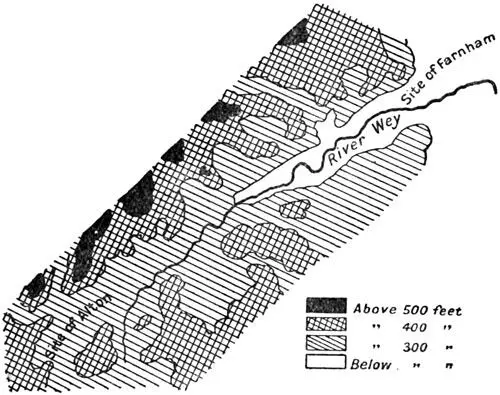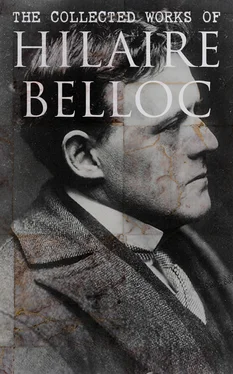These characters do not attach to the London turnpike after the fifteenth milestone is passed; it turns somewhat sharply to the right (or southward) and falls by a corner into the road from the Meon valley at the entry of Chawton village. Such a course one may be certain was not followed by the Old Road. It could not but have preserved the alignment which the valley had already given it, and which corresponds, moreover, with the High Street of Alton itself. For these seven furlongs there can be no doubt that it continued straight along the dip of the valley, and entered Alton on the northern side 20of the triangular common called 'The Butts,' by which one approaches the town from the south-west.
We were unable to prove this by direct examination; the main line of railway has here obliterated much by an embankment, and to this has been added all the new work of the Meon valley line, and the junction. The ground has therefore lost all its original character, and its oldest marks have disappeared. We made no attempt to follow the direct path for this short mile. We descended the high-road round by Chawton to Alton, and the first division of our task, the division in which a greater proportion of uncertainty would exist than in any other, was accomplished.
Comforted by such a thought, we drank mild ale at the 'Three Tuns' for about half an hour.
Alton to Shalford
Twenty-one miles
At Alton, with the green by which one enters the town from the west, begins a stretch of the Old Road, which stands by itself.
It may be roughly called the division between Alton and Farnham, but it stretches for a mile or two beyond Farnham to the pond at Whiteways, where the main road climbs the summit of the Hog's Back, and leaves the Pilgrim's Way a few hundred yards to the south.
This section, just over thirteen miles in length, has several peculiarities which distinguish it from the rest of the Road.
First —It follows the river Wey for miles, not as it followed the river Itchen, on a dry ledge above the stream, but right along the low land of the waterside. This is a feature in the Old Road not to be discovered in any other part of its course. It takes care to be within easy reach of water for men and horses, but it avoids the low level of a stream, and thick cover and danger of floods which such a level usually threaten. We had not found it (save for a very few yards) in immediate touch with the Itchen, nor should we find it later on running by the Mole, the Darent, or the Medway. Even the Stour, whose valley it is compelled to follow, it regards from heights well above the river.
Secondly —It runs for a part of this division upon clay, a soil which elsewhere it carefully avoids as being about the worst conceivable for a primitive and unmetalled road. Elsewhere (after Wrotham, for instance), it will make a detour rather than attempt any considerable stretch of gault; but here, for several miles along this valley of the Wey, it faces the danger.
Thirdly —In every other portion of its long journey it passes along the edge of habitations and tilled land; it was brought to do so by the same economic tendency which makes our railways to-day pass by the edges, not the centre of most towns; but here it must often have run right through whatever cultivation existed; at Alton, at Farnham, and in one village between, Bentley, it forms the high street of the place. A track which carefully just avoids Guildford, Dorking, Reigate, Westerham, Wrotham, Charing, and a dozen smaller places here touches and occasionally passes through the earliest groups of houses, the earliest pastures and ploughed fields.
Finally, there is a correspondence between it and the modern high-road for the whole of this considerable distance of over thirteen miles. In this character, again, the division we were now entering is unique.
We have indeed already found it identical with a modern road. The modern high-road also corresponds with the old way for something like a mile at Otford over the Darent, and for two or three miles beyond; it is a modern road for more than half a mile before you reach the ferry at Snodland, and there is a road in construction which follows its track for some hundreds of yards on Gravelly Hill, near Caterham. For many miles of its course it is identical if not with high-roads at least with metalled lanes, as we had already found between Itchen Stoke and Bishop Sutton, and very commonly with unmetalled tracks or paths. But in all these cases it is broken: there are stretches of it unused. Modern advantages and modern necessities have left the Old Road continually to one side. Here for this very considerable distance it is identical with the great turnpike, and so remains identical up to and beyond its point of junction with the older 'Harrow Way' at Farnham.
Can we discover any explanation for this coincidence of a prehistoric track with the high-road of our own time, which is almost indifferent to soil? for the crossing of the clay? for the neighbourhood of the river?
A little consideration will enable us to do so. The hills which everywhere else afford so even a platform for the prehistoric road are here of a contour which forbids their use. To-day, as a thousand years ago, any road down this valley must have run upon this lowest line.
The contour-lines, of which a rough sketch is here appended, are enough to prove it.

There is a deep combe at Holybourne Down, two more on either side of Froyle, a fourth beyond Bentley, a fifth—smaller—before Farnham. All these gullies cut up into a hopeless tangle what in Surrey and Kent will become one unbroken bank of chalk. Any path attempting these hillsides would either have doubled its length in avoiding the hollows, or would—had it remained direct—have been a succession of steep ascents and falls; all the dry slopes which bound the vale to the north are a succession of steep and isolated projections, thrust out from the distant main chain of the chalk; many of them are crowned with separated summits. The road is therefore compelled to follow the valley floor with all the consequences I have noted.
As far as Froyle, two and a half miles from Alton, it never leaves the river by more than a quarter of a mile, but the valley is here dry, the soil gravelly and sandy, the height considerable (above three hundred feet), and there is no reason why it should go further from the stream than it did in the valley of the Itchen. After Froyle you get the clay, and then right on through Bentley the road does attempt to get away northward from the stream, avoiding the marshy levels and keeping to the 300-feet contour-line. It does not approach the river again till firmer ground is found near the Bull Inn. Thence to within two miles of Farnham it has to negotiate a good deal of clay, but it picks out such patches of gravel as it can find, 21and it must be remembered that the valley of the Wey, in this early part, drains more rapidly, and has a less supply of water than that of the Itchen. Near Farnham, somewhat beyond Runwick House, it finds the sand again, and can follow along the low level without difficulty.
The Old Road keeps throughout this passage to the sunny northern bank of the river, so that, while it is compelled to keep to the bottom of the valley, it attempts at least to get the driest part of it.
Farnham, at the mouth of this valley, the point of junction between the Old Road and its still older predecessor from Salisbury Plain, was always a place of capital importance, especially in war. The Roman entrenchment, two miles up the valley, the Roman dwellings to the south, tell us only a little of its antiquity; and though our knowledge of the castle extends no further than the eleventh century, the fact that it was the meeting-place of the roads that came from Salisbury Plain, from the Channel, from London, and from the Straits of Dover, necessarily made it a key to southern England.
Читать дальше













